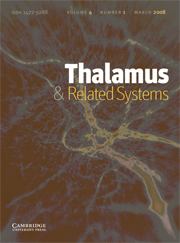Crossref Citations
This article has been cited by the following publications. This list is generated based on data provided by Crossref.
Alexander, G.M.
Carden, W.B.
Mu, J.
Kurukulasuriya, N.C.
McCool, B.A.
Nordskog, B.K.
Friedman, D.P.
Daunais, J.B.
Grant, K.A.
and
Godwin, D.W.
2006.
The native T-type calcium current in relay neurons of the primate thalamus.
Neuroscience,
Vol. 141,
Issue. 1,
p.
453.
Stern, Jair
Jeanmonod, Daniel
and
Sarnthein, Johannes
2006.
Persistent EEG overactivation in the cortical pain matrix of neurogenic pain patients.
NeuroImage,
Vol. 31,
Issue. 2,
p.
721.
Moazami-Goudarzi, Morteza
Sarnthein, Johannes
Michels, Lars
Moukhtieva, Renata
and
Jeanmonod, Daniel
2008.
Enhanced frontal low and high frequency power and synchronization in the resting EEG of parkinsonian patients.
NeuroImage,
Vol. 41,
Issue. 3,
p.
985.
Jones, Edward G.
2010.
Thalamocortical dysrhythmia and chronic pain.
Pain,
Vol. 150,
Issue. 1,
p.
4.
Walton, K. D.
Dubois, M.
and
Llinás, R. R.
2010.
Abnormal thalamocortical activity in patients with Complex Regional Pain Syndrome (CRPS) Type I.
Pain,
Vol. 150,
Issue. 1,
p.
41.
Garcia‐Rill, Edgar
2011.
Translational Neuroscience.
p.
83.
Henning Proske, J.
Jeanmonod, Daniel
and
Verschure, Paul F. M. J.
2011.
A computational model of thalamocortical dysrhythmia.
European Journal of Neuroscience,
Vol. 33,
Issue. 7,
p.
1281.
Perez-Reyes, Edward
and
Lee, Jung-Ha
2014.
Ins and outs of T-channel structure function.
Pflügers Archiv - European Journal of Physiology,
Vol. 466,
Issue. 4,
p.
627.
Fuggetta, Giorgio
Bennett, Matthew A.
Duke, Philip A.
and
Young, Andrew M.J.
2014.
Quantitative electroencephalography as a biomarker for proneness toward developing psychosis.
Schizophrenia Research,
Vol. 153,
Issue. 1-3,
p.
68.
Llinás, Rodolfo R.
and
Walton, Kerry
2014.
Chronic Pain and Brain Abnormalities.
p.
61.
Ribary, Urs
Doesburg, Sam M.
and
Ward, Lawrence M.
2014.
Magnetoencephalography.
p.
429.
Leuchter, Andrew F.
Hunter, Aimee M.
Krantz, David E.
and
Cook, Ian A.
2014.
Intermediate phenotypes and biomarkers of treatment outcome in major depressive disorder.
Dialogues in Clinical Neuroscience,
Vol. 16,
Issue. 4,
p.
525.
Garcia-Rill, Edgar
2015.
Waking and the Reticular Activating System in Health and Disease.
p.
157.
Leuchter, Andrew F.
Hunter, Aimee M.
Jain, Felipe A.
Tartter, Molly
Crump, Caroline
and
Cook, Ian A.
2017.
Escitalopram but not placebo modulates brain rhythmic oscillatory activity in the first week of treatment of Major Depressive Disorder.
Journal of Psychiatric Research,
Vol. 84,
Issue. ,
p.
174.
Lambert, Christian
Simon, Henry
Colman, Jordan
and
Barrick, Thomas R.
2017.
Defining thalamic nuclei and topographic connectivity gradients in vivo.
NeuroImage,
Vol. 158,
Issue. ,
p.
466.
Lii, Theresa R.
and
Saab, Carl Y.
2017.
Comprehensive Pain Management in the Rehabilitation Patient.
p.
3.
Chen, Erdong
Paré, Jean-Francois
Wichmann, Thomas
and
Smith, Yoland
2017.
Sub-synaptic localization of Cav3.1 T-type calcium channels in the thalamus of normal and parkinsonian monkeys.
Brain Structure and Function,
Vol. 222,
Issue. 2,
p.
735.
Tronnier, Volker
2018.
Neurochirurgische Schmerztherapie.
p.
73.
Basha, Diellor
Dostrovsky, Jonathan O.
Kalia, Suneil K.
Hodaie, Mojgan
Lozano, Andres M.
and
Hutchison, William D.
2018.
Gamma oscillations in the somatosensory thalamus of a patient with a phantom limb: case report.
Journal of Neurosurgery,
Vol. 129,
Issue. 4,
p.
1048.
Ribary, Urs
Doesburg, Sam M.
and
Ward, Lawrence M.
2019.
Magnetoencephalography.
p.
1.

